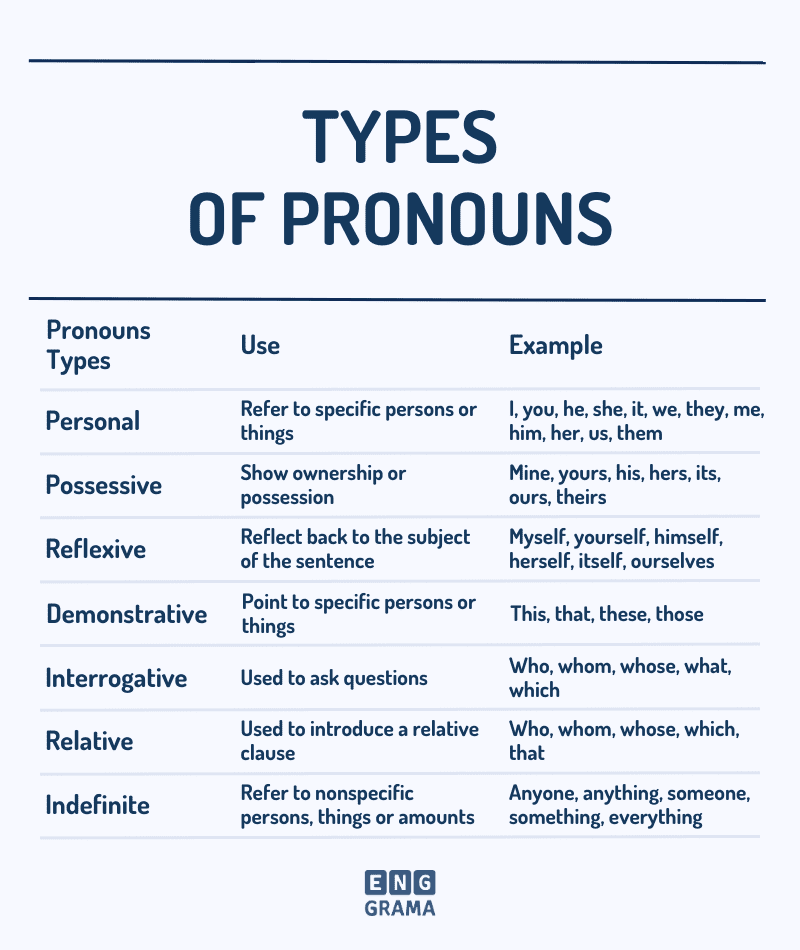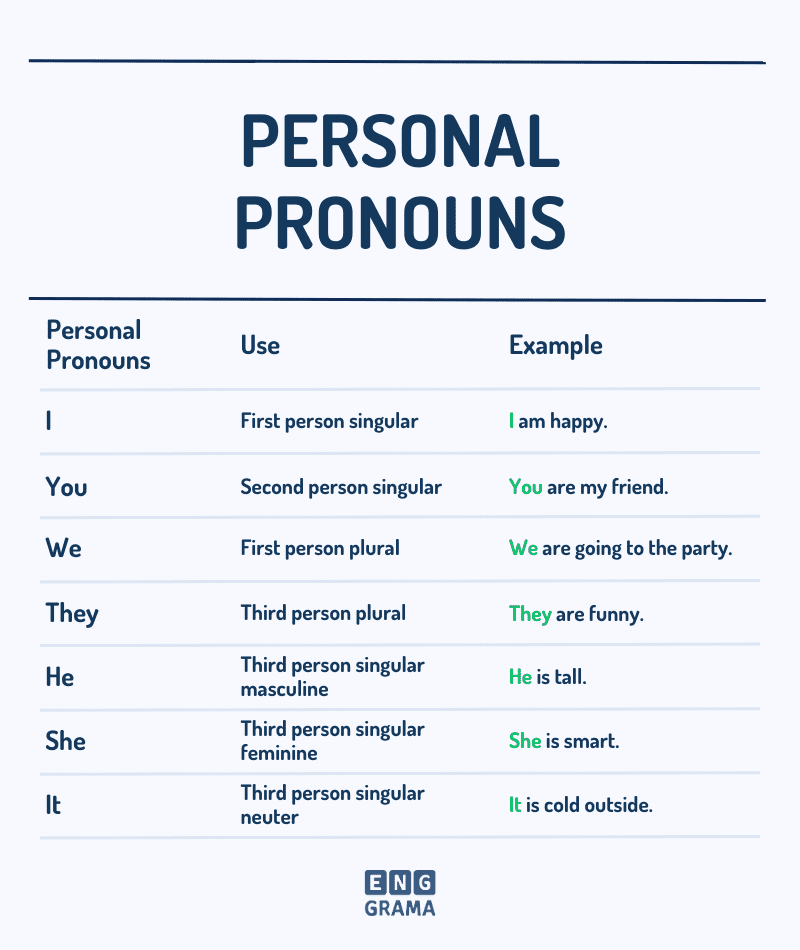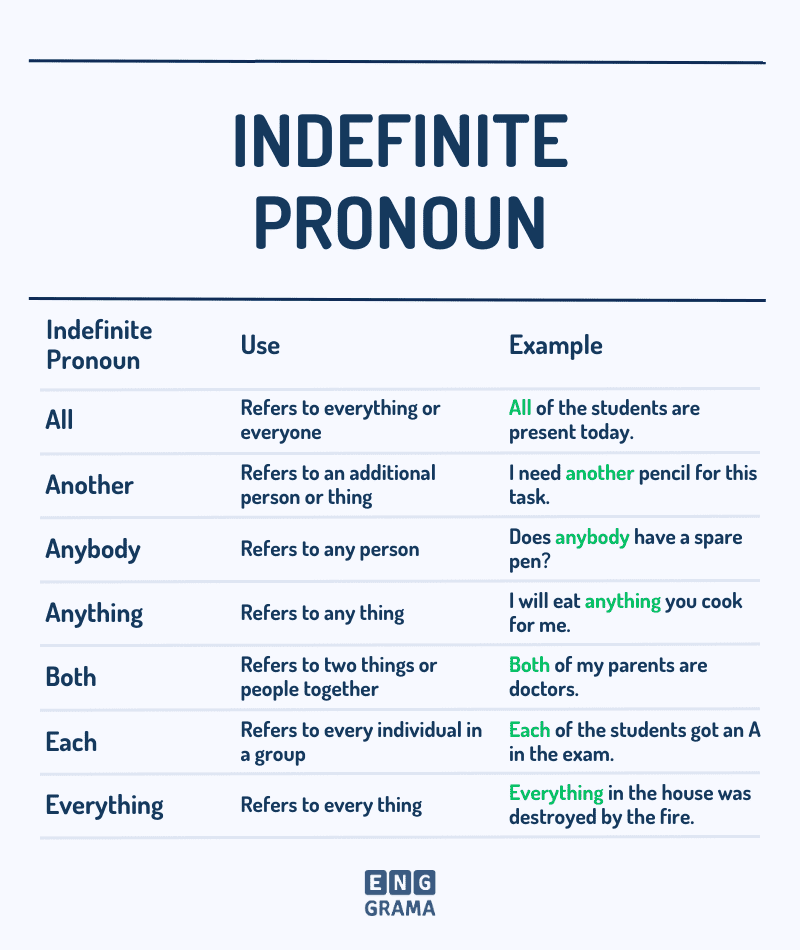HomePronouns
Pronouns
Pronouns Quiz
Mixed Pronouns
Test Your Pronoun Knowledge with Our Fun and Engaging Pronouns Quiz.
What Is Pronoun? | Different Types of Pronouns | Examples & Notes
For example,
Instead of saying “Ram went to the store and Ram bought some bread,” we can use a pronoun to make the sentence shorter and easier, like this: “Ram went to the store and he bought some bread.” Here we replace “John” with “he”. If we didn’t have pronouns we would repeat that sentences over again and again. So here how’s pronouns work.
Personal Pronouns
Words called personal pronouns are used in place of nouns. It is based on various factors.
Person: first person (I, we), second person (you), and third person (he, she, it, they)
Number: singular (I, you, he, she, it) or plural (we, you, they)
Gender: masculine (he, him), feminine (she, her), or neutered (it)
Case: subjective (I, you, he, she, it, we, they), objective (me, you, him, her, it, us, them), and possessive (my, your, his, her, its, our, their)
In summary, the choice of the personal pronoun is determined by the person, number, gender, and case of the noun that the pronoun is replacing.
Below we have mentioned some examples of Personal Pronouns:
“Why did the chicken cross the road? To get to the other side, of course! I mean, I think it was a chicken, but it could have been a duck. They both like crossing roads, don’t They?”
“I” (first-person singular)
“it” (third-person singular)
“they” (third-person plural)
“they” (repeated, referring to the same group as before)
“don’t” (contraction of “do” and “not”, both of which can function as auxiliary verbs for forming negative sentences or questions)
“He said he was going to organize a hide and seek competition, but it looks like good players are hard to find.”
“He” (third-person singular)
“he” (repeated, referring to the same person as before)
“it” (third-person singular, used as the subject of the sentence)
“to find” (infinitive verb form using the third-person singular form of the verb “to be”)
Possessive Pronouns
Possessive pronouns are used to show possession or ownership (car, dog, ball, table, and so on) of something, and they replace a noun that would normally indicate possession. Examples of possessive pronouns include “mine,” “yours,” “his,” “hers,” “theirs,” and “ours.”
Possessive pronouns can be singular or plural, depending on the number of the noun they are replacing. For example:
Singular: “This is my book.” “Is this yours?”
Plural: “These are our tickets.” “Are these yours?”
Person: Possessive pronouns can be first person, second person, or third person, depending on who the pronoun refers to. For example:
First person: “This is my hat.” “Is this ours?”
Second person: “Is this your pencil?” “Are these yours?”
Third person: “This is his wallet.” “Is this hers?”
Gender: Most possessive pronouns are gender-neutral, meaning they do not indicate the gender of the person or thing being referred to. However, there are some possessive pronouns that are gender-specific, such as “his” and “hers.” For example:
Gender-neutral: “This is their house.” “Are these yours?”
Gender-specific: “This is his car.” “Is this hers?”
Below we have mentioned some examples of Personal Pronouns:
“Is this yours or mine? I can’t remember, but I know it’s not theirs.”
“His pants are too big, but hers fit just right.”
“I found a dollar on the ground, so I picked it up and put it in my pocket. It’s mine now!”
“We have to decide whose turn it is to buy the pizza. Is it his, hers, or ours?”
“Their dog is so cute! I wish it was mine.”
Therefore,
If you want to sound like a language boss, just remember to always give proper nouns the capital letter respect they deserve.
Reflexive pronouns
Reflexive pronouns are a type of pronoun that reflect back to the subject of a sentence. They are formed by adding “-self”h (singular) or “-selves” (plural) to certain personal pronouns.
Some examples of reflexive pronouns include “myself”, “yourself”, “himself” “herself”, “itself”, “ourselves”, and “themselves”.
One of the most common ways to use reflexive pronouns is to emphasize the subject’s actions.
For example:
“I did it myself.”
By adding the reflexive pronoun “myself,” the speaker emphasizes that they completed the action without any help. This can also be used in a humorous way, such as,
“I tripped over my own feet and laughed at myself.”
In this case, “the speaker is both acknowledging their own clumsiness and making light of the situation.
Below we have mentioned some examples of Reflexive pronouns:
I told myself I wouldn’t eat that whole pizza, but I did anyway.
My dog looked at itself in the mirror and barked, thinking it had found a new friend.
She gave herself a high-five for completing her to-do list, even though it was 2 a.m.
We kept tripping over ourselves while trying to learn the latest TikTok dance.
They congratulated themselves on being the only people brave enough to wear matching jumpsuits to the party.
Demonstrative pronouns
Demonstrative pronouns are a type of pronoun used to point out or refer to specific people, places, or things. They can indicate whether the noun they refer to is singular or plural, and whether it is nearby or far away.
Some examples of demonstrative pronouns include “this”, “that”, “these”, and “those”.
“This is the last time I try to juggle flaming pineapples,” said the clown.
“That was a terrible idea,” said the cat as it watched its owner try to put on a Halloween costume.
“These are not the droids you’re looking for,” said the Star Wars fan to their bemused friend.
“Those cookies are calling my name,” said the cookie monster as he eyed a plate of freshly baked treats.
“This is why we can’t have nice things,” said the exasperated mom as she surveyed the mess her children had made.
Interrogative pronouns
Interrogative pronouns are pronouns that are used to ask questions. They are words like “who”, “whom”, “whose”, “what”, and “which”. These pronouns are incredibly useful in asking questions, and they are essential for us as part of everyday conversation. e.g. asking someone like, what do you do? where are you from?
Below we have mentioned some examples of Interrogative pronouns:
Who left the cake out in the rain? – This is a reference to the popular song “MacArthur Park” by Richard Harris. It’s a humorous way of asking who is responsible for a mistake or mishap.
What do you get when you cross a snowman and a shark? – A “frostbite”! This is a silly riddle that uses the interrogative pronoun “what” to set up the punchline.
Which came first, the chicken or the egg? – This is a classic philosophical question that uses the interrogative pronoun “which” to ask about the order of events.
Whom are you texting? – This is a more formal way of asking “who are you texting?” and demonstrates the use of the interrogative pronoun “whom” in more formal settings.
Relative pronouns
Relative pronouns can be confusing. They’re words like “who”, “whom”, “whose”, “that” and “which” that are used to connect one idea to another. But don’t worry, because with a few examples and some practice, you’ll be a pro at using relative pronouns in no time!
Moving on to “whose.” This relative pronoun is used to show possession. For example, “Whose phone is ringing?” is asking about the owner of the phone that’s ringing.
“The doctor whom was treating me had a terrific sense of humor.” That is ridiculous because “whom” is a word meant to refer to things, not people.
Moving on to “whose.” This relative pronoun is used to show possession. For example, “Whose phone is ringing?” is asking about the owner of the phone that’s ringing.
Here are the examples you will love it:
“The pizza that I ate for lunch was delicious. “This sentence is using “that” to introduce essential information about the pizza – that it was the one the speaker ate for lunch. But imagine if the sentence said, “The pizza which I ate for lunch was delicious.” That would imply that there were multiple pizzas being discussed, and the one the speaker ate for lunch was just one of them.
Finally, here’s a wacky example that uses both “that” and “which”: “The UFO, which had a strange glow, was the thing that I saw in the sky.” This sentence is using “which” to introduce non-essential information about the UFO – that it had a strange glow. And it’s using “that” to introduce essential information about the thing the speaker saw in the sky – that it was the UFO with the strange glow.
Indefinite pronouns
Indefinite pronouns are words that refer to an unspecified person, place, or thing. They can be tricky because they don’t refer to a specific noun, but rather a general concept. But don’t worry, with some practice and some examples, you’ll be a pro at using indefinite pronouns.
One common type of indefinite pronoun is “somebody”, which refers to a person whose identity is unknown or unspecified.
For example:
“Somebody left their lunch in the fridge.”
“Somebody should tell the cat that sleeping on the keyboard is not productive.”
Another type of indefinite pronoun is “something,” which refers to an unspecified thing.
“I think there’s something in my eye.”
“Somebody should tell the cat that sleeping on the keyboard is not productive.”
Another type of indefinite pronoun is “something,” which refers to an unspecified thing.
For example:
“I think there’s something in my eye.”
“I’m not sure what happened, but something tells me it wasn’t good.”
“Anywhere” is another indefinite pronoun, which refers to an unspecified place.
For example:
“We can go anywhere for dinner.”
“I’m not picky, I’ll eat anywhere as long as the food is good.”
“Anything” is an indefinite pronoun that refers to an unspecified thing.
For example:
“I’ll eat anything except anchovies.”
“I need to find my phone, it could be anywhere. Or anything, since I can’t remember where I left it.”
“Everyone” is an indefinite pronoun that refers to all people in a group, whether or not their identities are known.
For example:
“Everyone should bring their own water bottle.”
“Here’s a funny example: “I’m not saying everyone should dance, but it would make meetings more interesting.”
Finally, there’s “nobody”, an indefinite pronoun that refers to no person or thing.
For example:
“Nobody knows the trouble I’ve seen.”
“Nobody is perfect, but some people are better at it than others.
Note,
With these examples in mind, you can start to get a sense of how to use indefinite pronouns in your own speech and writing. Just remember, when in doubt, keep it general with indefinite pronouns!
To Practice and Improve Your Skills,








